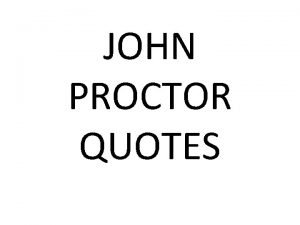How to Integrate Quotes in Literary Analysis A














- Slides: 14

How to Integrate Quotes in Literary Analysis A Simple Guide


POWER

Introduce a Quotation

Be Strong

Ellipses • When omitting words from within a single sentence, use only three ellipsis dots (. . . ). Three point ellipses have single typed spaces before and after each of the three dots: • Faulty: “water…had” • Correct: “water. . . had. ”

Brackets • Use brackets to specify ambiguous pronouns within a quotation. • Example: “ As revealed to me [Oedipus] by the Delphi oracle” (15).

You Do the Work • Do not rely on quotations to do the work for you. • You must always follow a quotation or paraphrase with commentary. Never end a paragraph with a quotation.

Make Changes • Quotations should fit into your argument. If punctuation, pronouns, or verb tenses do not flow with your own words, paraphrase or make minor changes to the quotation, surrounding them with brackets

Integrating Quotes: Pattern # 1 • 1. An introducing clause plus the quotation: Gatsby is not to be regarded as a personal failure because "Gatsby turned out all right at the end" (176), according to Nick. This is a complex sentence. Because is a subordinate conjunction.

Pattern # 2 • 2. An assertion of your own and a colon plus the quotation: • Fitzgerald gives Nick a muted tribute to the hero: "Gatsby turned out all right at the end" (176). This works best if your quotation is a complete clause

Pattern # 3 • 3. An assertion of your own with quoted material worked in: • For Nick, who remarks that Gatsby "turned out all right" (176), the hero deserves respect but perhaps does not inspire great admiration. This works best when you pull only power words from the quotation.

Final Reminders: • No quote ever stands alone. • Follow your quotes with commentary. • Do not begin commentary with words such as “this quote shows” or “this quote reveals. ”

Model Commentary • Taken from A Writer’s Model: “A Locust in the Garden” • The story alludes again and again to the sheltering comfort of the garden. The man tries to maintain an illusion that nothing serious happened to him, that in time he will “feel as if he had always been like that” (397). The garden is his refuge against reality.
 Properly integrated quote
Properly integrated quote Dialogue quote vs flow quote
Dialogue quote vs flow quote Embedding quotes in literary analysis
Embedding quotes in literary analysis Integrate unit step function
Integrate unit step function Differentiation by parts
Differentiation by parts Express definition
Express definition How to successfully integrate new employees
How to successfully integrate new employees Globalization collocation
Globalization collocation Sistem informatic definitie
Sistem informatic definitie Structured analysis and structured design (sa/sd)
Structured analysis and structured design (sa/sd) Joc didactic matematic animale domestice
Joc didactic matematic animale domestice Integration laws
Integration laws Sinumerik integrate
Sinumerik integrate Kentico infor integrate
Kentico infor integrate Access my machine siemens download
Access my machine siemens download



























